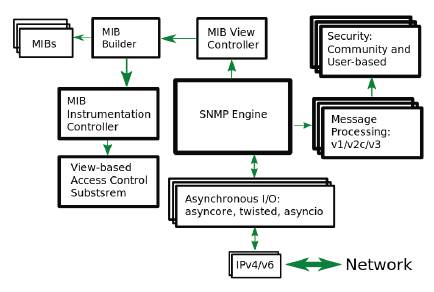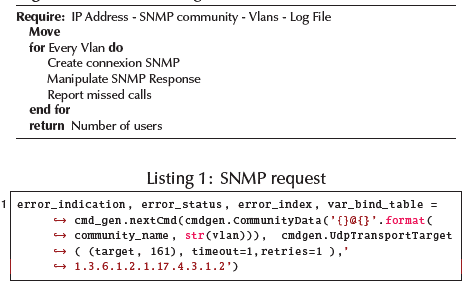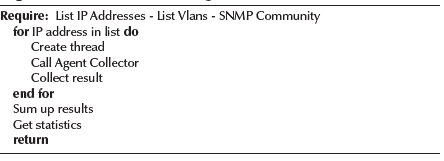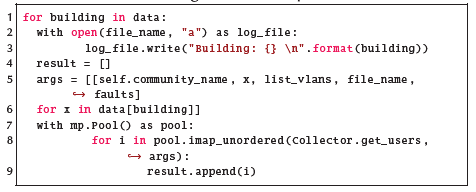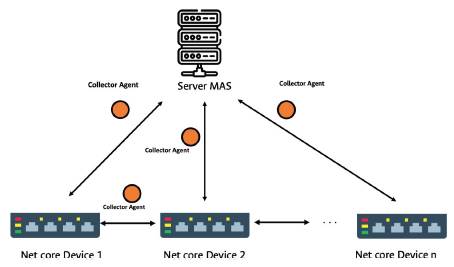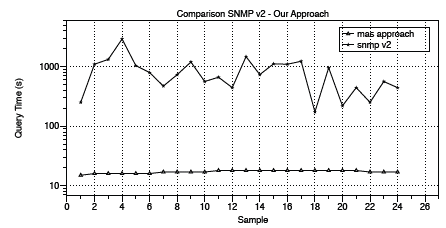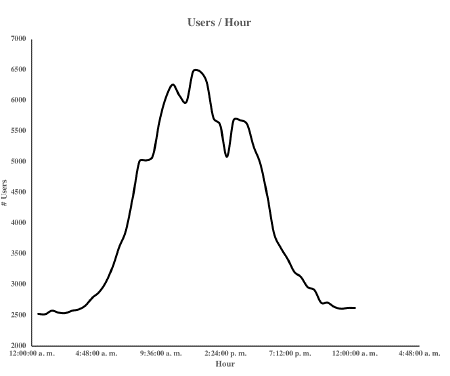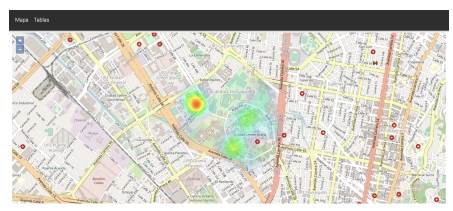Introduction
Today's networks are dynamic, and numerous transactions per second between different clients, applications, sensors, and devices are needed to deploy new services, which consumes the information generated throughout the network ecosystem. Traditional communication between network devices (Core and End Users) generates transactions in traffic control. In most cases, the Simple Network Monitoring Protocol (SNMP) is used to analyze traffic, with the purpose of allowing the administrators to change and monitor the state of devices that support the protocol, for instance, by shutting down an interface, checking the users on a Vlan, counting the users' sessions, etc. (Stallings, 1998; Goncalves et al., 2012). The SNMP has two types of entities: managers and agents. Managers work in Network Management Stations (NMS) and receive messages and traps from SNMP agents. SNMP agents, in turn, provide management information to the NMS. The agent is software-executed on a network device and incorporated into the operative system by the user-administrator. The SNMP protocol uses a hierarchical structure called Management Information Base (MIB). This structure is a database of managed objects containing information about the devices and the network. The MIB has two types of objects: scalar and tabular. These are useful to present the NMS information. The Object Identifier (OID) is organized in a tree-like hierarchy as a set of integers separated by dots, with the purpose of instantiating objects with a unique ID, for instance, devices and their function (router, switch), interface name, interface state, and so on Kaushik, 2010). SNMP's modularity helps it evolve through three major versions and find widespread use and acceptance. The IETF recognizes SNMP version 3, defined by RFC 3411 and RFC 3418, as the current standard version of SNMP. The IETF has designated SNMPv3 as a full Internet standard, the highest level of maturity for an RFC. In practice, SNMP implementations often support multiple versions: typically, SNMPv1, SNMPv2c, and SNMPv3. SNMP is a useful and versatile protocol that can work with other network information data sets, neural networks, machine learning systems, multi agent systems, or other monitoring platforms. For instance, in Sanchez et al. (2013) machine learning uses clustering and visualization techniques to identify and locate anomalous SNMP situations, and thus get an idea of network performance. Other approaches are focused on information security and cybersecurity to detect network attacks based on machine learning and event correlation (Hwoij et al., 2020; Al-Naymat et al., 2019).
Our approach is a campus network testbed based on a multi-agent system with mobile agents to monitor and present the location of users on a campus network via the SNMP protocol. The proposed model has three types of agents, i) the collector agent, ii) the consolidator agent, and iii) the painter agent.
This paper is organized as follows: the Methodology section shows the process used to design and implement the model; the Related Work section presents a review of existing solutions similar to our proposal; the Framework Architecture section introduces the reference models adopted in the debate for the system architecture and describes its components; the Use case section explains the implementation and its scope; the Results section describes the implemented prototype and the experimental demonstration of the proposed solution, showing its effectiveness; and, finally, the conclusions are presented in the Conclusions section, along with future work.
Methodology
Based on previous applications used on the university campus to measure the number of users per building, a new model is proposed that incorporates a multi-agent architecture to optimize data collection times on the network. A multi-agent model with SNMP was designed, developed, and implemented to allow comparative measurements between the two systems, as well as to verify the change in collection response times. The procedure is classified in three stages: (I) a description of the multi-agent architecture and the different layers and agents of the proposed model; (II) a description of the implementation and scope of the model; (III) an analysis of results and proposals for improvement.
Related Work
System monitoring and detection through the SNMP protocol with snmpwalk command routines are a solution to monitor and collect information about the network. However, this approach has huge response times, and it decreases the device's performance by consuming computing resources such as CPU and memory while querying on the MIB. The model presented by Brattstorm and Morreale (2017) uses metrics, collection, storage, presentation, and alerting to notify the system or device administrator or central control process of abnormal system or device behavior, where presentation is the way of displaying control data and issuing alerts. Another approach is proposed by Affandi et al. (2015) with a network mapping tool that sends early warnings via Short Message Service (SMS). The process starts with metwork mapping using the SNMP agent on all network interfaces. The information contained in the agents is retrieved and processed as Transport Control Protocol (TCP) traffic. Finally, a monitoring system checks TCP traffic and the use of computing resources. This process allows the bandwidth and resources optimization to manage the emergency systems and control some variables via SNMP agents.
An implementation to monitor networks and systems is proposed by some authors with a generic matrix grammar (Min, 2011; Garcia et al., 2014). This framework uses some protocols to display and monitor the system, such as Windows Management Instrumentation (WMI), Computer Integrated Manufacturing (CIM), and SNMP to remotely collect and manage NMS data. The authors propose a monitoring automation engine with a matrix analyzer into the multi-agent-based solution. Additionally, the most widely used monitoring information systems use a traditional snmpwalk command to enable system integration with any management tool with SNMP support such as Nagios (Barth, 2008), SNMP MIB Browser Android Tool (Hidalgo and Gamess, 2014), and Manage Engine MIB Browser Free Tool (Free SNMP Walk Tool for Windows and Linux, n.d.). A layered approach is introduced by Wan et al. In this paper, a smart emergency system is proposed. This model collects data from urban areas, and its most important task is to detect an emergency and handle it in a timely fashion to ensure protect human integrity and the continuous operation of critic infrastructures.
Other auhtors have developed SNMP and multi-agent systems (Barruiso et al., 2017; Moreira et al., 2016; Torre and Yucelen, 2018). The first model is a proposal for a mechanism to provide flexibility and dynamism using virtual agent organizations (VO) embedded in different wireless sensors, which are embedded in devices with limited computational resources. The PANGEA framework incorporates features to the wireless sensor network such as adaptability, reorganization and learning capabilities, its agents have a control role in atomatically collecting and processing information. This approach allows using the MAS as a virtual organization to define the structure, roles, and hierarchies, thus regulating the interaction and communications between agents and network devices via SNMP and MIB analysis. The second approach uses the SNMP protocol to manage ubiquitous systems through behavior graphs and a metric called the expected behavior representation (GoES). This method allows the link between SNMP agents and commercial off-the-shelf systems (COTS). The approach consists of characterizing the context of devices and testing whether they are able to understand what other systems are doing by monitoring their state. Finally, the approach with mobile agents described by Madi and Alkasassech, 2019) is a simulation with a Omnet + + network simulator that aims to use the mobile agent on the network with different amounts of nodes (5, 10, 15, 20, and 30 nodes in the proposed scenario). The objective is to probe an algorithm to improve SNMP queries using two type of agents: link and data agents. The link agent is responsible for discovering the network and storing the connected nodes in the home server. The data agent is responsible for data retrieval.
Another approach focused on the choice of a methodology to design and implement multi-agent systems to design the monitoring system, as shown in Lin and Jiang (2014), to introduce the design steps and organizational methods such as GAIA and Ingenia. Based on the methodological approach, Isaza et al. used JADE as a multi-agent framework and the GAIA methodology to monitor 32 personal computers.
There are models without the SNMP protocol to monitor university campus networks with specific architectures, as is the case of lot, deployed as a platform to characterize energy consumption (Moura et al., 2021) in order to manage electrical resources or electrical grids (Chiadone et al., 2019). Another approach used to monitor networks includes Software Defined Networks (SDN) techniques to monitor traffic flows on lot devices. These models need two psychic channels to monitor the network: the data plane and the control plane (Pashamoktari et al., 2020).
Finally, network monitoring has evolved into the field of cybersecurity as a monitoring system on a campus and industry infrastructure to identify and mitigate potential vulnerabilities (Laštovička etal., 2020), in addition to analyzing the network flow with recurring neural networks (Yang et al., 2020), wireless analysis (Jin etal., 2019; Allahham and Rahman, 2018), or risk assessment (Awang et al., 2020).
Our approach is an intermediate model proposed to monitor campus network core devices (routers, switches, and manageable network devices) and as a possible platform to deploy some monitoring systems for other variables taken from sensors, personal computers, or other linked devices within the campus network.
Framework Architecture
Our approach contemplates a three-layer architecture as shown in Figure 1 with mobile agents and a dispersion strategy to scan the campus network. Each of these layers has a specific task to accomplish an objective and finally obtain the number of users present in the network as a heat map. All the services are deployed on an virtual server on the private cloud infrastructure of the University.
Data collection layer: It is the bottom layer that establishes communication with the SNMP agents using the Pysnmp library to make the query with the OID code on the MIB. It contains the collector agents (mobile agent).
Data processing layer: It is the intermediate layer that consolidates all the data obtained from all the collecting agents. It is also tasked with deploying and organizing the collecting agents. It summarizes, analyzes, and draws statistics from the data obtained.
Application layer: Its is the top layer that displays the collected information. It contains the application agent that creates the different web files to present data in the form of a heat map. Furthermore, all the data obtained from the preceding layers are also available in tables for ease of use and analysis.
PySNMP library
The library that has been used for our implementation is PySNMP (PySNMP 4.4.12, n.d), a free and open source implementation of the v1/v2c/v3 SNMP engine that is distributed under a 2-clause BSD license. It manages different layers as an evolution of SNMP We have used only the first layer of Pysnm2 in the implementation (Figure 2). This layer covers a basic and low-level protocol scope (SNMP v1/v2) in order to make a simple implementation and use all the power of the SNMP API to use the core functions of the SNMP protocol. Figure 2 shows the modular architecture of the library. Not all functionalities have been used in this work, but it can provide a handful of easy to use tools.
A brief description of the library is presented below:
SNMP engine: it is a central object that controls the other components of the SNMP system.
Transport subsystem: it is used to send SNMP messages and accept them from the network. The I/O subsystem consists of an abstract dispatcher and one or more abstract transport classes.
Message and PDU dispatcher: its main responsibilities include dispatching PDUs from SNMP applications through various subsystems, all the way down to the transport dispatcher, as well as passing SNMP messages from the network up to SNMP applications.
Message Security Modules: it performs message authentication and/or encryption. At the time of this writing, the User-Based (for v3) and Community (for v1/2c) modules are implemented in PySNMP. All security modules share the standard API used by the message processing subsystem.
Message processing modules: it handles message-level protocol operations for current and possibly future versions of the SNMP protocol. Most importantly, they include message parsing/building and possibly invoke security services when required.
MIB modules: used by the SNMP engine to maintain its configuration and operational statistics.
Data collection layer-collector agent
The collector agent has only one task: to communicate with an SNMP agent. These agents receive all the information needed from the preceding layers: the SNMP community name and the node target. The work of these agents is entirely reactive, as they only respond to the demands of the second layer. They manage errors that can be generated during SNMP communication and report them to the next layer; the algorithm overview is shown in Algorithm 1. In order to get the expected values, some parameters are needed to identify certain core switches in the network. Some of the given parameters are switch number, rack number, telecommunications enclosure room ID and its respective floor number, and building number of the university campus to which the device belongs (according to the building nomenclature). All these fields have three descriptive characters.
As shown in Algorithm 1, the work of each collector agent requires parameters such as lan, network scope, and SNMP community. The algorithm starts with a loop for every vlan on the switch. Each vlan is isolated from the others and, to make a more realistic measurement, all available vlans must be analyzed. Each of these changes the SNMP community, as a complement to SNMP validation. As a result, this validation is as follows: SNMPCommunity@VLAN_NUMBER. Communication problems may occur. Each SNMP request that files are logged along with the switch IP address and the associated vlan. Once the work is finished, the agent moves on, and the result is taken by the consolidator agent.
The nextCmd method provided by the Pysnmp library allows to perform a snmpwalk operation by iterating over the MIB with OID 1.3.6.1.2.1.17.4.3.1.2. The "dotldTpFdbPort" allows reading a table with the MAC addresses that have been seen through a given port. As we make use of an SNMP walk operation, we do not need to specify a port, but we go through all possible ports to get an accurate measurement.
Consolidation layer-consolidator agent
Agents in this layer are tasked with getting all the network devices to be scanned and deploying collector agents. This implementation, as shown in Algorithm 2, considers a pool of threads, each collector agent will manage its own thread, and the consolidator agent is responsible for synchronizing and managing the threads. The consolidator agent will call each agent, assign them a target and manage their response. The target is an IP address of the network devices. Each one of these threads has an independent execution. Communication between these execution time agents is asynchronous; hence, we can make use of distributed parallel processing at jobs (mobile agents), thus reducing network delay and execution time. When the collector agent completes its work, the consolidator agent has to examine the data. In this step, the consolidator agent logs some information in terms of performance or errors, with the objective of making statistics. Therefore, the data is sent to the presentation layer. The logic of this agent is presented as follows.
This agent receives information from the presentation layer as the SNMP community and the name of the file source. These parameters are given to the collector agents to accomplish their tasks. Here the input file is analyzed with a mapping between physical buildings, IP references and vlans. For each physical building, a log file is created with a pool of threads. Each thread is going to point to a network device in that building. After the execution of the mobile agents' collection is done, the results are logged and added to the statistics. The final data is exposed to the presentation layer. The input file is represented as follows:
Physical section: Section code and name, switches in this section together with uplink port
Mapping: Buildings names and codes, network device count, number of buildings
List of vlans: Name, range IP.
In this part of the code, we iterate over the list of buildings, logging the obtained data. In line 7, a pool of collector agents are called. This call acts asynchronously using all the processors available in the machine through the PySNMP library. In line 8, the call to the collector mobile agents is made along with the information related to the device managed by SNMP.
Application layer-application agent
This layer is responsible for initializing the system and displaying the results, as shown in Algorithm 3. During the initialization, the consolidation agents are called and assigned their tasks. Once all the underlying layers (collection and consolidation) have finished their work, they send the results to the presentation layer, where they are computed, and a HTML file is created. This file contains the HTML code necessary to display a heat map, helped by the OpenLayers open source technology. To complete the map, the application agent takes the coordinates and publishes the information as a web server. Thus, all the University's buildings can be appropriately named and pointed in this map. These coordinates were taken in the geodetic coordinate system 'EPSG:4326' in order to make the data available for future use. Styles and actions modules (javascript) were created with a user-centered design approach. The web module is done, and a python script is responsible of serving web files to make them available over the network. The result is shown in Figure 6. The gradient color has a variation from 0 to 1 according to the OpenLayers specification. The weight of each point on the map is calculated between the number of users present in the whole building versus the total number of people in the university, with red being the closest to 1, turning greener the farther away they are.
Use case
Monitoring a complex system such as a campus network requires mechanisms that efficiently verify the status of users and services on the network. For this experiment, the capacity of the proposed mechanism will be measured by verifying the number of connected users on campus. The empirical experiment was carried out in the facilities of Universidad Nacional de Colombia (Bogotá), which currently has 152 buildings, out of which 129 belong to the faculties, and the remaining 23 correspond to cultural and extension centers located at different points of the city. These facilities have an average of more than 40 000 end users, including undergraduate, postgraduate and extension students, professors, administrative staff, and the general public. At the data network level, there are 73 buildings interconnected to the wired network (optical fiber and ethernet), which have approximately 30 000 structured cabling points, and are distributed in 210 telecommunications enclosures. There are 620 network core devices (switches and routers), which provide approximately 15 000 wired network connections. The university has network management and monitoring systems, such as HP Network Node Manager and Cisco Prime, which are used to monitor network problems such as equipment failures, network loops, or resource saturation (memory, processor, or channel bandwidth) on network equipment. The information provided by these systems is consolidated, which includes the total number of connected users or the distribution of users per vlan. However, obtaining particular information as to how many users are connected in a building or on a specific floor is not possible in real time, so other systems are required to analyze the data, and more processing time is spent. With SNMP, it is possible to consult the network from the core equipment network by analyzing the information of the connected users with an SNMP walk agent. However, the time consumption and processing are too high for the network's monitoring needs.
To monitor and manage the quantity of users in a specific building or floor, the consolidator agent sends the collector agents from the server located in the main data center and checks the network management devices in each building. The second phase is to analyze the information form the collector agents and create the tables and data useful to publish them on the web server, which managed by the application agent.
As shown in Figure 3, the experiment was deployed on Vmware vsphere 6.5, on a virtual server with 4 vcores (Physical core Intel(R) Xeon(R) CPU E5-2699 v3 @ 2.30GHz), 16 GB RAM, and 100 GB of storage. The operative system was Centos 7. The server works as a web server managed by the application agent; the MAS deployed on python uses the specific agent roles to first send the collector agents as a thread on the network. In some cases, the agent can be deployed and cloned on the server or embedded devices near the net device to collect the information. Mobility is limited, and it is possible to an ambient as a destination with an exposed port (the collector agent needs to know the route). Next, the collector agents return to the server or send the information collected from the net core device, i.e. the query on the MIB. The information is analyzed by the consolidator agent, and it creates information files to present on the application layer as a heat map and information table on the web server.
Results
The results of this empirical approach presented below are not comparable with other schemes proposed in the literature, such as those presented by Isaza et al. (2007), which are based on simulation environments. In the case of this work, it is an implementation that raises the technical rigor of the unloading of this system as a service without depending on frameworks such as JADE or Pangea, which are limited by the simulation scenario, that is, abstraction at the software level. In our case, the multi-agent system prototype used for network monitoring was implemented and deployed in computer equipment and network devices such as switches or a router.
The data to carry out the experiment was taken from two sources. The first is the legacy system that uses SNMP2 and sequentially goes one device at a time collecting data. The second source is the proposed multi-agent system model, where data are collected in parallel on the device. Measurements were made every hour, running both systems and measuring execution times. The results obtained from multiple executions for three months of data are represented in graphs to facilitate comprehension.
In Figure 4, the analyzed data show how time is reduced because of the proposed architecture: a massive amount of agents going through the network with separated zones. Due to the way in which SNMP acts within the network, the time could be extended due to network traffic. This network traffic may cause some SNMP errors that affect the measurements and a certain number of users. Node query time with the traditional SNMP process walk takes more than one hour. In contrast, our approach with a multi-agent system architecture with some mobility reaches averages of 21,83 minutes on the wired campus network (122 network core devices at 73 buildings). During that period, the consolidation process, map creation, and publishing take place.
High traffic on the network and restrictions in the communications channel are some of the factors that make the collection time variable. In this sense, measurements take longer when there are more requests for navigation and service access by users, thus generating an additional load for the agents deployed over all the network devices registered in the system. This non-controllable variable is characterized in Figure 4, where we have the average measurements of the working days of the week. This behavior is close to the self-similar traffic. This sample allows additional management decisions to be made during this period of the day.
Other useful information to characterize user behavior is taken from the collector agents, such as the normal state of the wired network on campus. This information allows determining the amount of users per hour, as show in Figure 5, with a peak of 6 500 users linked to the network at noon. It was taken on work days in a regular academic semester for three months. This information allows planning of network resources, like switches, vlans, or management systems, infrastructure changes, and new service design. It can also be used to identify anomalous behavior as a security thread.
All types of agents in the model are designed to be customizable, this gives them the ability to make more queries on other specific MIB. This feature allows scaling the solution and taking even more data from the equipment registered in the system, not only the number of users, as seen in Figure 5. The information collected by the system peaks at noon.
This behavior allows characterizing the network and serves as input for a fault detection system or to detect anomalies that can be categorized as cyber-attacks. Finally, the information is displayed on the web server and published on the University's LAN, as shown in Figure 6.
Conclusions
In this work, we used a multi-agent system with some mobility characteristics to determine the number of users on the campus network and the density in specific buildings, reducing the data collection time by one third of the normal time. The agents were used to collect, analyze, and present information about the campus network in less time than traditional SNMP queries.
The obtained results also allow describing user behavior on campus. This information is useful as an input for modelling normal traffic for planning and decision-making for scaling and management of the campus network.
All types of agents in the model are designed to be customizable, this gives them the possibility of making more queries about other specific MIBs. This feature allows scaling the solution and taking even more data from the equipment registered in the system, not just the number of users. The model would even allow the simultaneous use of several types of collecting agents, each one collecting data for a specific problem to be solved.
We demonstrated the effectiveness of our solution on a case study by implementing the MAS system on a campus network. Our approach allows using other tools apart from the the SNMP protocol for the monitoring or analysis of telecommunications networks. This design based on multiple agents is scalable to allow the incorporation of other protocols in the collection and analysis of the data to convert it into information or present it in the form of a report or graphical interface. It can be used at the level of energy consumption calculation, in a similar way as those presented in the literature (Laštovička et al., 2020; Jin et al., 2019; Allahham and Rahman, 2018), with the great difference of reducing the number of sensors required, that is, the hardware component is reduced through the estimation of energy levels based on theoretical models, and some agent of the developed system is in charge of computing them.
Traditional network management and monitoring schemes made up of the management server and manageable devices, based on the SNMP protocol, have allowed different manufacturers to guarantee a monitoring scheme, offer specialized products, and create their own MIBs. However, as the number of links and core devices within the network grows, latency becomes an additional element that constitutes a limitation for managing these resources, determining the status of the network, and having a complete view of a system. For this reason, the scheme, combined with multiple agents and parallel computing, allows making a network management scheme based on distributed architectures, applications, and algorithms that allow optimizing the use of network protocols, programming language libraries, and operating systems.
This approach increases the impact and reach of these processes, and it is the novelty of this prototype. In the same way, it is not limited or non-scalable like proprietary monitoring platforms such as Nagios or Cisco Monitoring, which only use the SNMP protocol to review records and some states of network devices.
Finally, thanks to the customization capacity of the agents, it is possible to define write-type agents, which would allow the system to modify parameters in the network to improve performance or prevent issues. As for future improvements to the model, focusing on the mobility of the consolidator agent is proposed, thus allowing the coexistence of several of these agents, allowing them in turn to run on different devices in the network. This would facilitate the use of the new capabilities of network equipment that allow running Python on their operating systems, which would most likely further reduce data collection times.















